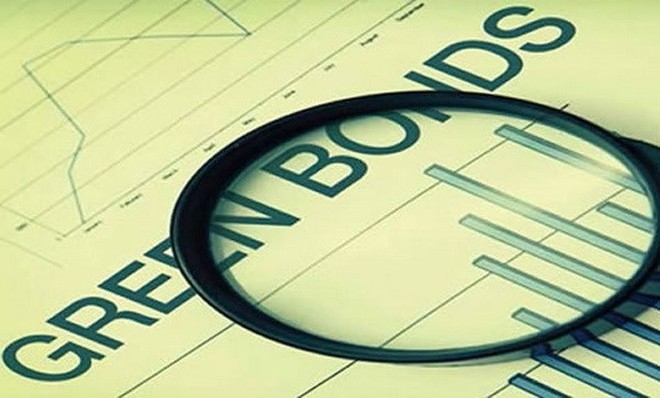On August 6, Minister of Industry and Trade Nguyen Hong Dien signed and issued Decision No. 2259/QD-BCT on the promulgation of a plan to develop a government decree regulating policies on the import and export of goods, the distribution of goods and services, commodity trading floors, and the operations of commodity exchanges in Vietnam’s international financial center.
For the green finance trading floor, the draft proposes stipulating that the listing and trading of green financial products be limited to those meeting environmental standards and criteria prescribed by the Ministry of Finance and the Ministry of Agriculture and Environment (MAE), referenced to international practices and standards. Meanwhile, the carbon credit trading floor will facilitate the trading of credits in accordance with international standards. This requires a transparent measurement - reporting - verification (MRV) mechanism, valid certification from competent authorities, and compliance with regulations on storage, information disclosure, and fraud prevention in carbon trading.
According to experts, developing a green finance market in conjunction with a carbon credit market can effectively mobilize capital for emissions reduction projects, representing a financial mechanism that contributes to mitigating the impacts of climate change and addressing environmental challenges.
Initial efforts
From August 1, Decree No. 119/2025/ND-CP dated June 9, 2025, from the government amending and supplementing a number of articles in Decree No. 06/2022/ND-CP on greenhouse gas emission reduction and ozone layer protection, officially took effect.
Regarding carbon market regulations, the Decree stipulates that by the end of 2028, Vietnam will have established a National Registration System; built and piloted a domestic carbon trading floor; implemented mechanisms for exchanging and offsetting domestic carbon credits; and carried out activities to enhance capacity and raise awareness about developing a carbon market.
From 2029, it will develop and implement a mechanism for auctioning greenhouse gas emission quotas; complete regulations on carbon credit management and the exchange of emissions quotas and credits; and finalize the legal framework for organizing, managing, and operating the domestic carbon market as well as participating in the global carbon market.
The establishment of a carbon market is expected to create new financial flows for activities aimed at reducing greenhouse gas emissions, promoting Vietnam’s green transformation, and developing low-emission technologies. This will contribute to building a low-carbon economy and proactively responding to climate change, with the ultimate goal of achieving net-zero emissions by 2050, as committed to at COP26 in late 2021.
According to Associate Professor Nguyen Dinh Tho, Deputy Director of the Institute for Strategy and Policy on Agriculture and Environment at the MAE, Vietnam is building robust carbon market infrastructure in various stages to ensure accountability over emissions. Emissions quotas are being set, and businesses will eventually face compliance costs if they exceed allowable limits. A pilot carbon credit trading platform will pave the way for full implementation.
In parallel, legal provisions are being drafted to oversee credit transfer rules, including participation in international markets. Major emitters must begin compiling inventories in accordance with regulations under Decree No. 06. Environmental protection targets, meanwhile, are being translated into national action plans that prioritize infrastructure resilience, water efficiency, and ecosystem restoration.
Deputy Prime Minister Tran Hong Ha signed Decision No. 21/2025/QD-TTg on July 4, stipulating environmental criteria and procedures for confirming investment projects in the green classification list. This decision, Associate Professor Tho believes, marks an important milestone in Vietnam’s green finance roadmap, helping define the boundary between projects with genuine environmental benefits and those that do not safeguard, or even harm, the environment. “Establishing mandatory environmental criteria is a strategic step to screen projects, ensuring that only truly green activities are certified and enjoy policy incentives,” he said. “This legal framework supports domestic programs and facilitates Vietnam’s access to international climate finance resources, carbon credit mechanisms, and public-private partnerships in sustainable development.”
In Vietnam, banks are increasingly mobilizing the necessary capital, particularly low-cost funding for green loans, with major institutions such as BIDV, Vietcombank, and Agribank taking the lead. Credit institutions are also proactively seeking partnerships with international organizations to implement green credit programs. Examples include the Renewable Energy Development Project (REDP) and the Vietnam-Energy Efficiency for Industrial Enterprises Project (VEEIE), funded by the World Bank, as well as renewable energy projects supported by loans from the Japan Bank for International Cooperation (JBIC).
At the same time, regulators are building a support framework that includes financial instruments, investment incentives, and institutional guidance to channel capital into climate-friendly projects. According to experts, the development of green credit mechanisms, expanded access to concessional loans, and a stronger domestic green bond market demonstrate Vietnam’s commitment to creating a financial environment where environmental and economic benefits align. Institutions are exploring models that allow for flexible credit risk management and interest rate advantages for projects that align with national climate goals.
Strengthening connections
Experts have said that if green credit provides capital for projects certified with carbon credits, then carbon credits also present an opportunity to export goods to other countries.
Associate Professor Tho noted that in the agriculture sector, sustainable aquaculture stands out for its high export potential but also carries significant environmental risk. Unsustainable practices in feed use, mangrove deforestation, and untreated wastewater pose serious ecological threats.
Green bonds can finance projects that convert operations to closed-loop systems that recycle water, introduce sustainable alternative materials such as insect protein, and fund mangrove restoration efforts capable of generating green carbon credits. For perennial crops such as coffee and pepper, both important exports for Vietnam, green bonds can enable agro-forestry models, water-saving irrigation, and precision inputs to reduce land degradation.
Vietnam’s forests also require urgent financing to conserve biodiversity and store carbon. Green bonds can support sustainable forest management projects to prevent deforestation and promote reforestation in degraded areas.
The Associate Professor added that while funding committed under the Just Energy Transition Partnership (JETP) provides a valuable foundation for Vietnam’s emissions reduction goals, it covers only a small portion of the estimated $360 billion needed to achieve net-zero emissions by mid-century. “Establishing a clear green taxonomy would help investors and lenders identify eligible projects aligned with sustainable development goals,” he suggested. “Once the carbon market is fully operational, which is expected by 2029, it will create incentives for low-carbon initiatives and emissions reductions.”
According to Dr. Luong Quang Huy, Head of the Greenhouse Gas Emission Reduction and Ozone Layer Protection Division within the Department of Climate Change at the MAE, developed countries are at the forefront of establishing both voluntary and compliance carbon markets, often closely linked to green finance mechanisms.
In the US, the Regional Greenhouse Gas Initiative (RGGI) demonstrates the benefits of linking regional carbon markets, with clear positive impacts on renewable energy. Since its inception, the RGGI has helped reduce CO₂ emissions from the electricity sector in participating states by more than 50 per cent, while boosting investment in renewable energy and energy efficiency.
Elsewhere, Australia also has experience with compliance carbon markets - the Emissions Reduction Fund and Safeguard Mechanism - alongside green financing initiatives. In China, the national emissions trading market has expanded rapidly, supported by fiscal policies that promote investment in green finance markets. And in ASEAN, progress is being made through the launch of sustainability-linked bond standards and the ASEAN Sustainable Finance Taxonomy. Among member states, Singapore has introduced a carbon tax that allows companies to meet part of their tax obligations through the purchase of third party-certified carbon credits.
Vietnam can draw many important lessons from international experience, Dr. Huy said. “This includes prioritizing the establishment of a strong legal framework for both green finance and a carbon market; ensuring the quality and additionality of carbon credits through a complete and unified MRV system; maintaining independent appraisal to avoid the pitfalls of some voluntary carbon markets; and actively attracting the financial sector by offering incentives and building capacity to channel green capital flows into emissions reduction projects,” he explained.
Quote:
| “Developed countries are at the forefront of establishing both voluntary and compliance carbon markets, often closely linked to green finance mechanisms.”Dr. Luong Quang Huy, Head of the Greenhouse Gas Emission Reduction and Ozone Layer Protection Division, Department of Climate Change, Ministry of Agriculture and Environment |









 Google translate
Google translate